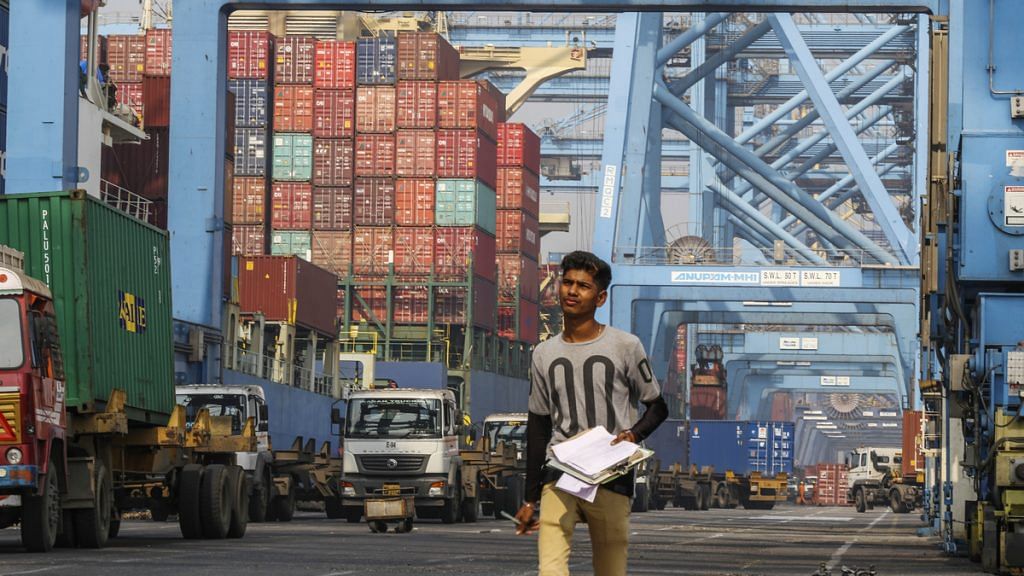New Delhi: For the first three quarters of 2021-2022, India’s merchandise exports showed a higher growth rate than imports as compared to pre-pandemic levels. This, according to analysts, is a “positive trend” driven by economic recovery from the pandemic compounded by growing external demand for Indian goods.
Merchandise imports were higher in value than exports for the first nine months of the current fiscal — as has been the trend for several years and is evident in India’s large trade deficit.
However, exports grew approximately 5 percentage points higher compared to pre-pandemic levels, according to an analysis of commerce ministry data released last Friday.
Merchandise exports touched $301.38 billion in April-December 2021, showing a 26.49 per cent increase over the same period in 2019 — before the pandemic. In contrast, merchandise imports touched $443.82 billion for the same period, showing a 21.87 per cent increase over the same period in 2019.
This comes at a time when India has set a target to touch $400 billion in merchandise exports by the end of this fiscal, having already crossed $300 billion in the first 9 months.
In an interview with ThePrint earlier this month, Union Minister of State for Commerce and Industry Anupriya Patel said, “India’s economic recovery is expected to gain further strength in the remaining quarters of the financial year on the back of upbeat market sentiments, rapid vaccination coverage, strong external demand and continuous policy support by the government and RBI. However, the new Omicron variant poses a challenge to the sustained recovery.”
Also read: Omicron a challenge to economic recovery, but India learnt from 2nd wave: MoS Anupriya Patel
‘Global countercyclical policies driving up external demand’
Asked what could be driving the high growth rate of merchandise exports, Zico Dasgupta, a macroeconomics expert and Assistant Professor at Azim Premji University, said, “I think this reflects some recovery of exports from the pandemic and, on top of that, the countercyclical policies across the world which are pushing up external demand in a few countries where India exports.”
Top performing commodities included petroleum products, engineering goods and gems and jewellery. However, non-petroleum and non-gems & jewellery exports during April-December 2021 grew nearly 30 per cent over the same period in 2019 too.
Ajay Sahai, Director General and CEO of Federation of Indian Export Organisations (FIEO), a trade promotion body under the commerce ministry, pointed out that although imports growth is lower than exports growth, the former has a higher base.
“The fact that India’s exports have shown a higher growth rate in these past three quarters is positive, no doubt, but we require the differential growth in our exports and imports to be a little higher to make a difference to the trade balance sheet,” he told ThePrint.
According to government data, India’s trade deficit has typically hovered around $160 billion for the past three years.
Asked what a higher export growth rate means for India’s goal of reaching $1 trillion in goods exports by 2030, Sahai said, “Our exporters are seeing a huge number of orders coming to the country because of the ‘China Plus One’ business model, improved quality of Indian goods, and also the fact that we are getting more involved in value-addition of exports.”
Also read: 5 factors will shape Indian economy in 2022, and you can be cautiously optimistic despite Covid
Export vs import growth rates in previous years
During the pandemic, exports and imports fell drastically, distorting their growth rates.
The last time exports showed higher growth than imports was in FY17. According to government data, exports increased from $197.3 billion in the first three quarters of 2015 to $199.42 billion in the same period in 2016 — a growth of 1.07 per cent. However, imports saw a decline from $297.36 billion to $277.76 billion in the same period — a 6.59 per cent drop.
The Economic Survey for FY17 had said the reason imports declined in 2016 was due to volatility in oil prices and a sharp decline in gold imports.
In FY18, however, the growth of imports exceeded that of exports. Exports increased 11.68 per cent in the first three quarters of 2017 as compared to the same period in 2016 while imports grew 23.59 per cent, according to government data.
This trend followed in FY19 too. Exports increased 9.5 per cent in the first three quarters of 2018 compared to 2017, while imports grew 14.25 per cent.
However, in FY20, both imports and exports declined. Exports fell from $244.03 billion in April-December 2018 to $238.27 billion for the same period in 2019 — a 2.36 per cent decline. Meanwhile, imports fell from $392.26 to $364.18 billion — a 7.15 per cent decline.
At the time, analysts suggested that this was “the hallmark of a slowdown”. Further, it was reported that the decline in imports was led by industrial inputs like coal, chemicals, iron, and steel and consumer items such as precious and semi-precious stones while Indian exporters were weighed down by liquidity issues.
This is an updated version of the report
(Edited by Manoj Ramachandran)
Also read: India Jewellery Park to be set up in Mumbai, aims to attract Rs 20,000 crore investment
